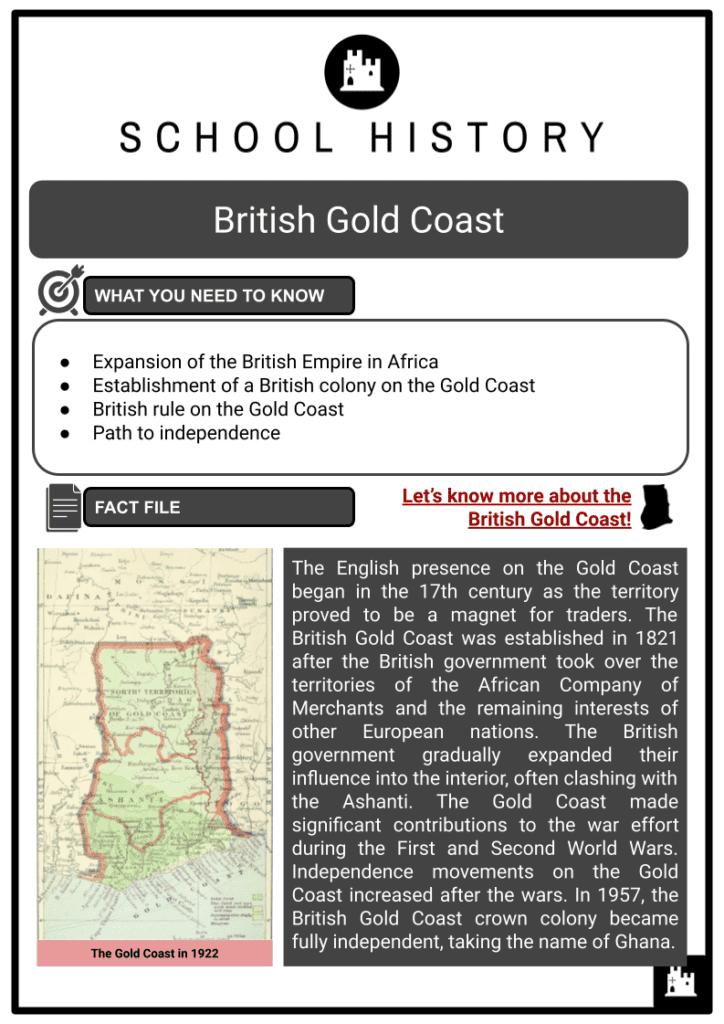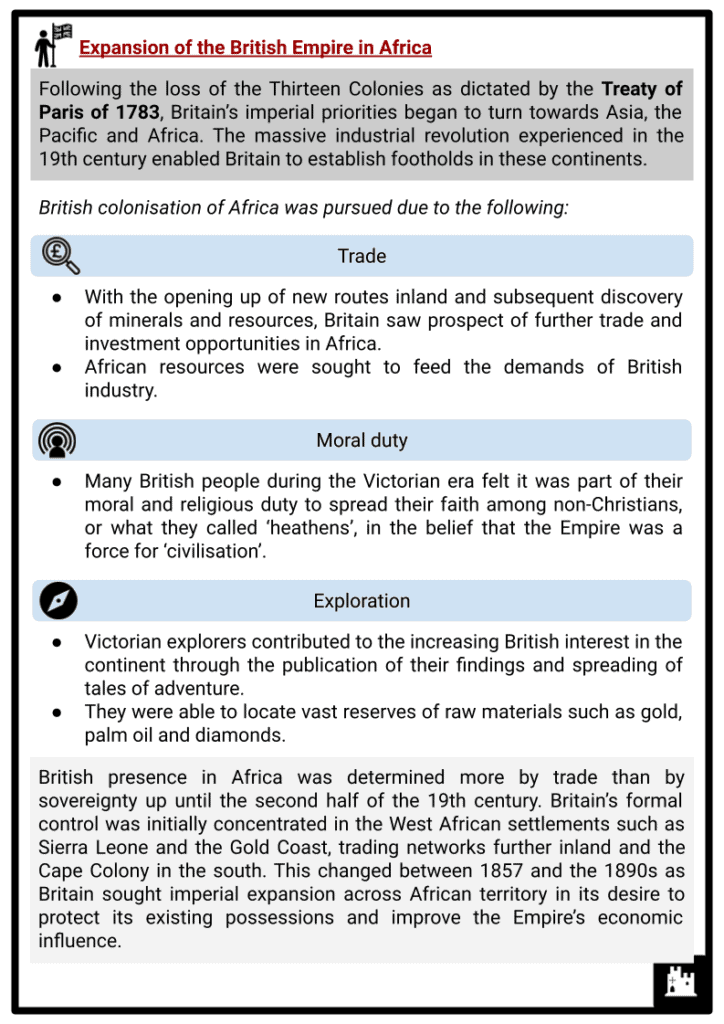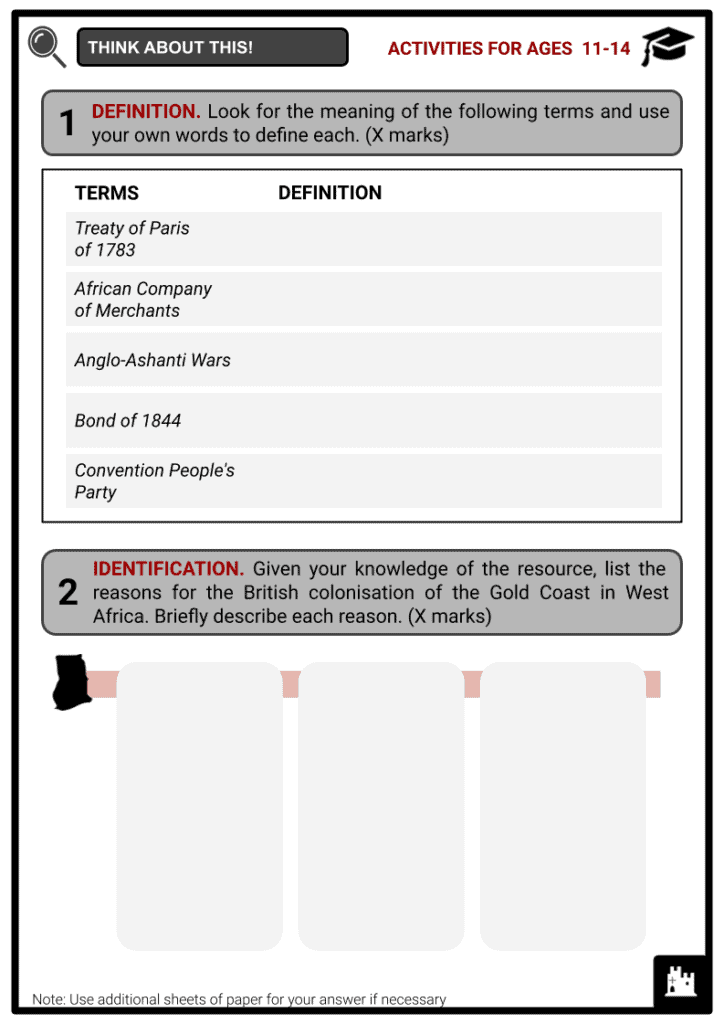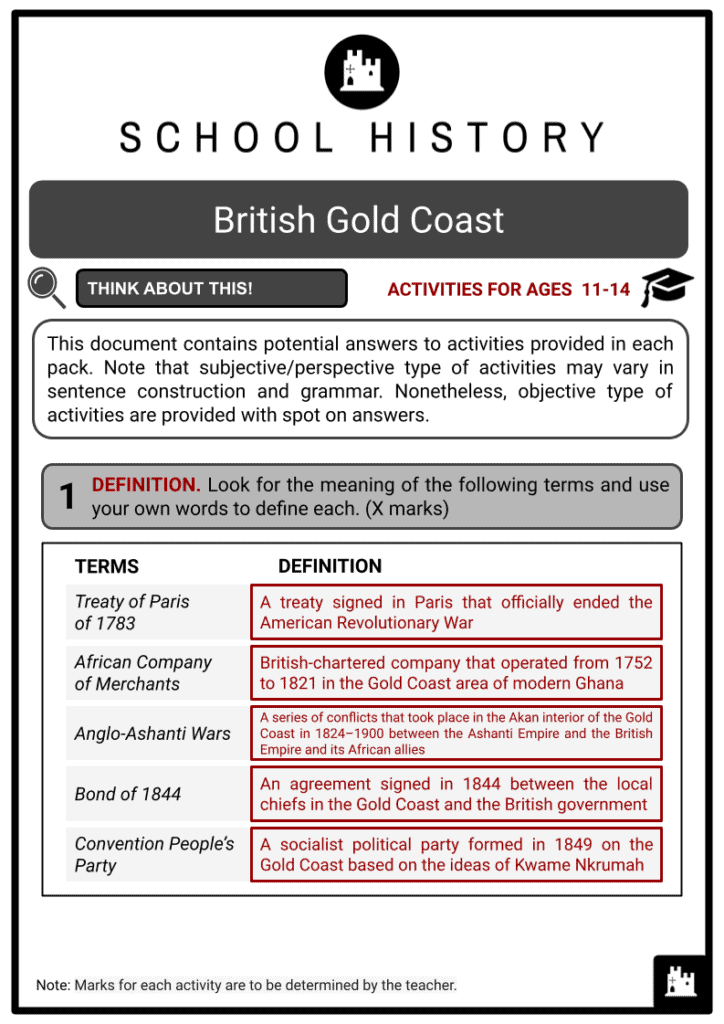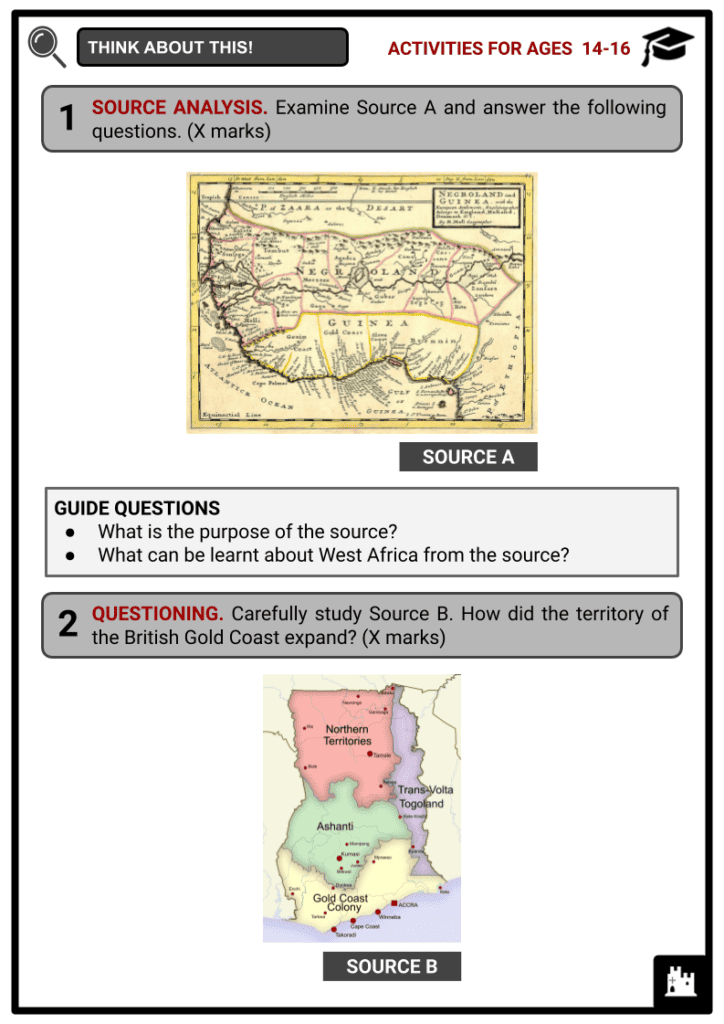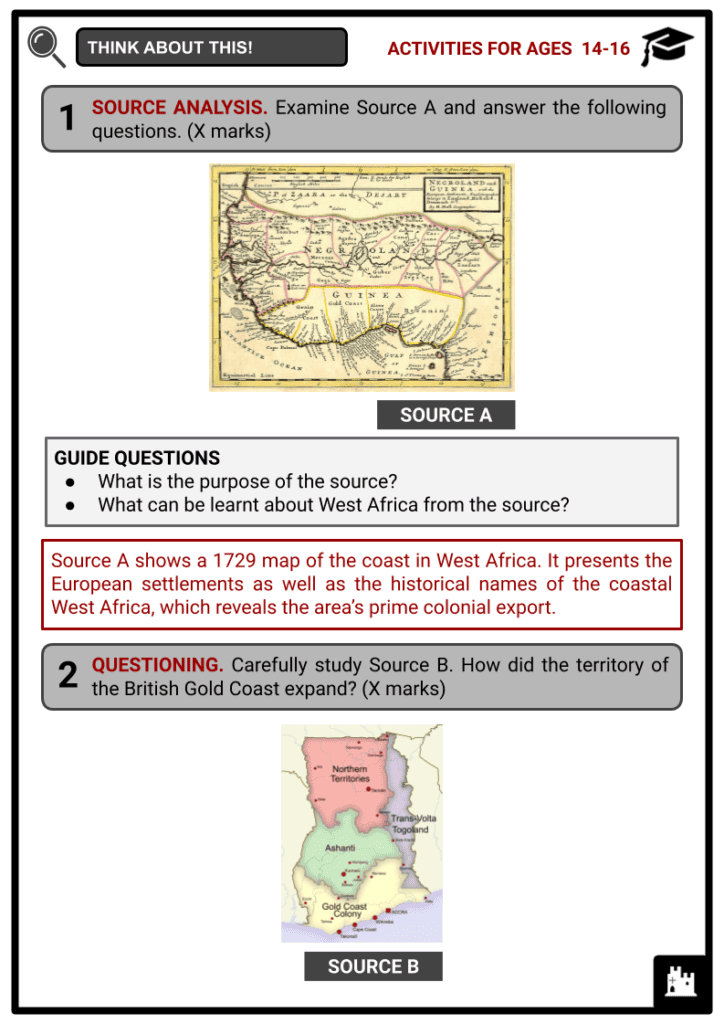British Gold Coast Worksheets
Do you want to save dozens of hours in time? Get your evenings and weekends back? Be able to teach about the British Gold Coast to your students?
Our worksheet bundle includes a fact file and printable worksheets and student activities. Perfect for both the classroom and homeschooling!
Summary
- Expansion of the British Empire in Africa
- Establishment of a British colony on the Gold Coast
- British rule on the Gold Coast
- Path to independence
Key Facts And Information
Let’s know more about the British Gold Coast!

The English presence on the Gold Coast began in the 17th century as the territory proved to be a magnet for traders. The British Gold Coast was established in 1821 after the British government took over the territories of the African Company of Merchants and the remaining interests of other European nations. The British government gradually expanded their influence into the interior, often clashing with the Ashanti. The Gold Coast made significant contributions to the war effort during the First and Second World Wars. Independence movements on the Gold Coast increased after the wars. In 1957, the British Gold Coast crown colony became fully independent, taking the name of Ghana.
Expansion of the British Empire in Africa
- Following the loss of the Thirteen Colonies as dictated by the Treaty of Paris of 1783, Britain’s imperial priorities began to turn towards Asia, the Pacific and Africa. The massive industrial revolution experienced in the 19th century enabled Britain to establish footholds in these continents.
British colonisation of Africa was pursued due to the following:
Trade
- With the opening up of new routes inland and subsequent discovery of minerals and resources, Britain saw prospect of further trade and investment opportunities in Africa.
- African resources were sought to feed the demands of British industry.
Moral duty
- Many British people during the Victorian era felt it was part of their moral and religious duty to spread their faith among non-Christians, or what they called ‘heathens’, in the belief that the Empire was a force for ‘civilisation’.
Exploration
- Victorian explorers contributed to the increasing British interest in the continent through the publication of their findings and spreading of tales of adventure.
- They were able to locate vast reserves of raw materials such as gold, palm oil and diamonds.
- British presence in Africa was determined more by trade than by sovereignty up until the second half of the 19th century. Britain’s formal control was initially concentrated in the West African settlements such as Sierra Leone and the Gold Coast, trading networks further inland and the Cape Colony in the south. This changed between 1857 and the 1890s as Britain sought imperial expansion across African territory in its desire to protect its existing possessions and improve the Empire’s economic influence.
Establishment of a British colony on the Gold Coast
- European nations had sought to take advantage of the natural and human resources of West Africa as early as the 15th century. The first European explorers that had moved into and built several forts along the coastline in the area known for its large gold resources, the Gold Coast, were the Portuguese. The gold and the transatlantic slave trade soon attracted other European nations including England.
- The Gold Coast became a magnet for traders eager to make their fortune.
- In the 17th century, the Dutch replaced the Portuguese as the leading European nation in the territory while the English continued building forts along the coast.
- The two nations often clashed with one another during this period and the Dutch proved superior.
- In 1752, the English Crown founded the Royal Trading Company with rights to monopoly access to English markets at least. The chartered company constructed several trading posts or factories at Dixcove, Sekondi, Accra, Whydah and other places.
- The African Company of Merchants later took over the monopoly and reorganised to make the transatlantic slave trade more efficient.
- When the Act for the Abolition of the Slave Trade was passed in 1807, the chartered company’s profitability was crippled but continued to operate some years forward.
- The British government withdrew the African Company of Merchant’s charter in 1821 and seized its privately held territory along the coast. In the same year, it formed the British colony on the Gold Coast as a dependency of Sierra Leone after having taken over the remaining interests of other European nations. It also granted authority over the British forts to Charles MacCarthy, governor of the colony of Sierra Leone.
British rule on the Gold Coast
- Following the establishment of the British Gold Coast, the British government began increasing their influence into the interior. Meanwhile, the Ashanti, who were a major force in the Akan interior, also wanted to extend their rule and promote and protect their trade. Apart from its desire to strengthen its influence, the British government was also concerned that the Ashanti were still catering to the other European nations that had not yet abolished the slave trade. Consequently, the Anglo-Ashanti Wars broke out, becoming one of the main issues on the British Gold Coast.
Events on the British Gold Coast
- With a mandate to enforce peace and end the slave trade, the British clashed with the Ashanti, leading to a war that lasted from 1823 to 1831. In the battle of Nsamankow in 1824, the governor of the Gold Coast, MacCarthy, was killed and almost all the British force were wiped out immediately. The British suffered another defeat at Efutu but the Ashanti were unsuccessful when they tried to take the formidable Cape Coast Castle.
- In 1826, the new governor of the Gold Coast, John Hope Smith, mustered a combined force of British and local forces hostile to the power of the Ashanti. They successfully defeated an Ashanti invasion of the coast.

A depiction of the first Anglo-Ashanti War - Concerned at the cost of the war that brought limited success, the British government ordered all British officials and garrisons to withdraw to Sierra Leone in 1828 and authorised the London Committee of Merchants to maintain the forts on their behalf.
- The British merchants founded a governing body to protect themselves and their interests known as the council of merchants. In 1831, Captain George Maclean, president of this council, arranged a peace treaty with the Ashanti and the Pra River was accepted as the border.
- Under Maclean’s administration, no clashes with the Ashanti took place and trade reportedly improved. Moreover, a number of coastal tribes had submitted voluntarily to British protection. Maclean’s efficient administration on the Gold Coast led a parliamentary committee to suggest that the British government permanently administer its settlements and negotiate treaties with the coastal chiefs to improve Britain’s relations with them.
- From 1843, the British government decided that a Governor of the Gold Coast was to be appointed subordinate to the Governor of Sierra Leone. Commander Henry Worsley Hill was appointed to this post. Hill went on to determine the conditions and responsibilities of his jurisdiction over the protected areas and negotiated a special treaty with several Fante and local chiefs that became referred to as the Bond of 1844. This document laid the legal foundation for succeeding British colonisation of the coastal area.
- The Bond of 1844 designated the British with the duty to provide security to the coastal areas, hence other coastal states and states further inland gradually signed the bond. This saw the expansion and acceptance of British influence in the territory. By 1850, the coastal protectorate had increased and the administration of the Gold Coast was separated from Sierra Leone. Also in 1850, the Danes offered to sell their forts to the British government and threatened that if their offer were not to be accepted, they would instead offer them to other powers. Consequently, the British purchased the forts from the Danes.
- As the British presence was increasingly accepted, another significant move occurred in the 1850s. In 1852, local chiefs and elders convened at Cape Coast to confer with the governor on means of raising revenue. With the governor’s approval, the council of chief established itself as a legislative assembly.
- The second Anglo-Ashanti War broke out in 1863 with a huge Ashanti force crossing the Pra River in search of a fugitive. A combined force of British, West Indian and African troops responded to this attack. Neither side achieved a decisive victory as illness took more casualties on both sides than the actual fighting. The conflict ended in a stalemate in 1864.
- The year 1872 saw another expansion of British influence on the Gold Coast following the purchase of the Dutch Gold Coast including the coastal town of Elmina, which had been claimed by the Ashanti since the 17th century. This led to the third Anglo-Ashanti War that lasted from 1873 to 1874.

Depiction of the third conflict - The Royal Navy had to land marines on the Gold Coast while General Garnet Wolseley was sent to the territory along with thousands of British, West Indian and African troops. This time, the British had superior tactics and weaponries over the Ashanti, enabling their victory. In early 1874, the Treaty of Fomena was signed between the Ashanti and the British, in which the Ashanti were required:
- to pay an indemnity of 50,000 ounces of gold
- to renounce claims to Elmina and to all payments from the British for the use of forts
- to terminate their alliances with several other states
- to withdraw their troops from the coast, to keep the trade routes open
- to halt the practice of human sacrifice
- Following the defeat of the Ashanti, the British declared the settlements on the Gold Coast and Lagos as a separate crown colony in 1874. The Gold Coast Colony consisted of the coastal areas and extended inland as far as the ill-defined borders of the Ashanti. The British also moved the colonial capital from Cape Coast to the former Danish castle in Accra.
- In 1886, Lagos became a separate colony from the Gold Coast.
- In 1891–94, the British offered the Ashanti to become their protectorate. The Ashanti king rejected to surrender his sovereignty but was willing to offer concessions to the British. In fact, the Ashanti sent a delegation to London and negotiated but the British had already decided on a military solution. The fourth Anglo-Ashanti War was briefly fought from December 1895 to February 1896, resulting in the defeat of the Ashanti. The Ashanti king was pressured to sign a treaty of protection and then was exiled.
- The final Anglo-Ashanti War, also known as the War of the Golden Stool, occurred in 1900. This rebellion led to many fatalities on both sides. In 1901, the Northern Territories of Ashanti were annexed to the British Gold Coast.
- During the First World War from 1914 to 1918, the Gold Coast Regiment was mobilised and served with distinction in battles against German forces in Togoland, Cameroon and in the long East Africa campaign. The territory also contributed to the cost of the war through various funds.
- In the Second World War, the Gold Coast supplied resources and manpower for the Allies. The Gold Coast troops again served with distinction in such places as Ethiopia and Burma. The end of the conflict showed Britain that running the Empire was more trouble than it was worth.
- By the end of the Second World War, the Gold Coast colony was the richest and most educated of the territories in West Africa. A strong spirit of nationalism evolved in this educated population.
Path to independence
- The 1946 Gold Coast Constitution, a bold document that instituted changes in the Legislative Council, failed to grant full self-government since the British continued to regard the colonies as a source of raw materials that were needed to strengthen their crippled economy.
- In 1947, the United Gold Coast Convention (UGCC) was created by educated Ghanaians and was the first nationalist movement with the aim of self-government.
- While the movement opposed colonial administration, it did not seek revolutionary change.
- In 1948, public dissatisfaction with the UGCC culminated in the rioting and looting in Accra and other towns and cities over issues of pensions for ex-servicemen, the dominant role of settler-colonists in the economy, the shortage of housing, and other economic and political grievances.
- Following the riot, Kwame Nkrumah, one of the UGCC founders, broke with the organisation and created the Convention People’s Party (CPP) in 1949.
- The party was supported by ex-servicemen, literate persons, journalists and primary school teachers, and later on, by industrial workers.
- The CPP put pressure on the British administration to make further concessions.
- Consequently, the Legislative Council was expanded and became the Legislative Assembly.
- The British governor retained ultimate power.
- In 1950, Nkrumah launched the Positive Action campaign, demanding a constituent assembly to write a constitution.
- This led to violence and the arrest of Nkrumah and other CPP leaders. Nkrumah was sentenced to a total of three years in prison.
- In the February 1951 legislative election, the CPP was elected in a landslide.
- It became clear to the British that the CPP would have to be brought into government in order to keep the resistance under control.
- Nkrumah was released and given the position of Prime Minister from 1952.

Flag of Ghana - Additionally, members of the CPP were appointed as government ministers. Nkrumah’s popularity further grew.
- In 1956, a plebiscite in the neighbouring British Mandate of Togoland decisively voted in favour of unification with the Gold Coast.
- At the time, massive support for independence led to full adult suffrage in the 1957 elections.
- The British Gold Coast crown colony became fully independent on 6 March 1957, taking the name of Ghana, an ancient African state on the edge of the Sahara Desert. Ghana was the first sub-Saharan African country to gain independence from European colonisation.
Image Sources
- https://upload.wikimedia.org/wikipedia/commons/thumb/e/e7/The_agricultural_and_forest_products_of_British_West_Africa%3B_%281922%29_%2817945019825%29.jpg/800px-The_agricultural_and_forest_products_of_British_West_Africa%3B_%281922%29_%2817945019825%29.jpg
- https://upload.wikimedia.org/wikipedia/commons/thumb/4/4c/NAM-1971-02-33-1-1.jpg/1920px-NAM-1971-02-33-1-1.jpg
- https://upload.wikimedia.org/wikipedia/commons/9/9f/Anglo-Ashanti_war_2.jpg
- https://upload.wikimedia.org/wikipedia/commons/thumb/1/19/Flag_of_Ghana.svg/1024px-Flag_of_Ghana.svg.png
Frequently Asked Questions
- What was the British Gold Coast?
The British Gold Coast was the name given to the region that is now modern-day Ghana when it was under British colonial rule from the late 19th century until it gained independence in 1957.
- When did the British take control of the Gold Coast?
The British gradually established control over the Gold Coast during the late 19th century. They signed treaties with local leaders, established forts and trading posts, and eventually solidified their dominance.
- How did colonial rule affect the Gold Coast?
Colonial rule brought significant changes to the Gold Coast. The British introduced new administrative systems, infrastructure, and education. However, it also led to exploiting local resources and people, including forced labour and land dispossession.

